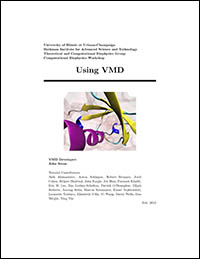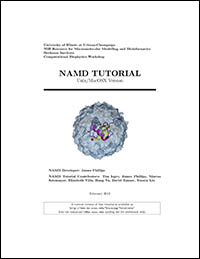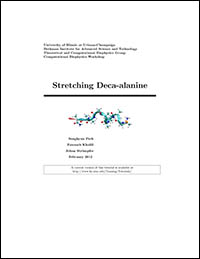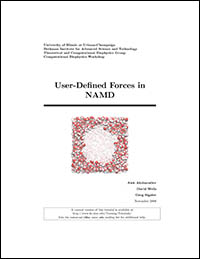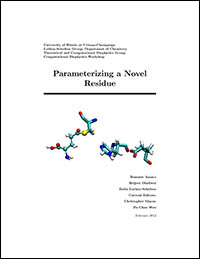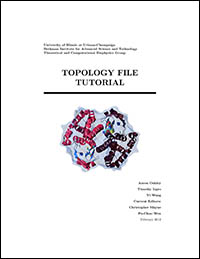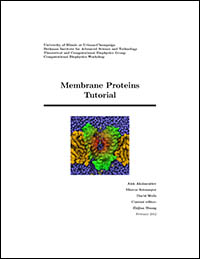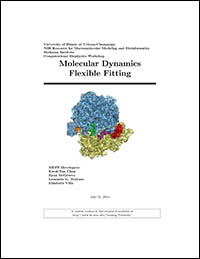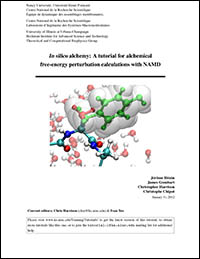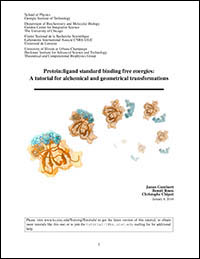Computational Biophysics Workshop - Atlanta, Nov. 3-7, 2014
Tutorials
In the hands-on afternoon sessions, you will have the option to work on a variety of tutorials. The tutorials recommended for this workshop are listed below. You can find a list of all existing tutorials
here.
Using VMD:
- Participants build an image of ubiquitin while becoming familiar with basic VMD commands. Additionally, participants learn how to look for interesting structural properties of proteins using VMD. Tutorial works on Windows, Mac, an
d Unix/Linux platforms.
- Instructions: [html] [pdf, 1.4M]
- Required tutorial files: [.tar.gz, 44.9M], [.zip, 44.9M], individual files
NAMD Tutorial:
Stretching Deca-Alanine:
- This tutorial will introduce the user to interactive molecular dynamics (IMD) and steered molecular dynamics (SMD) simulations, and to the calculation of potential of mean force (PMF) from trajectories obtained with SMD simulations.
- Instruction: [html] [pdf, 1.4M]
- Required tutorial files: [.tar.gz, 5.3M], [.zip, 5.3M], individual files
User-Defined Forces in NAMD:
- This tutorial is designed to guide users of VMD and NAMD in the use of the tclForces and tclBC scripts. These script-based facilities simplify the process of adding complex forces to systems and implementing boundary conditions. Tutorial works on Windows, Mac, and Unix/Linux platforms.
- Instructions: [html] [pdf, 4.3M]
- Required tutorial files: [.tar.gz, 306M], [.zip, 306M], individual files
Parameterizing a Novel Residue:
- Takes participants through a comprehensive example of how one investigates, sets up, and simulates a small nonstandard ligand bound to a protein system; specifically, the glutaminase subunit of the hisH-hisF system and determining the parameters for the non-standard residue. Requires VMD, NAMD, and Spartan. Tutorial works on Windows, Mac, and Unix/Linux platforms.
- Instructions: [html] [pdf, 2.5M]
(html for Linux) (pdf for Linux, 2.5M)
- Required tutorial files (all versions): [.tar.gz, 24.2M], [.zip, 24.2M], individual files (all versions)
Topology File Tutorial:
- Guides users in how to create topology and parameter information needed for molecular dynamics simulations when it otherwise doesn't exist, by using existing topology information for other molecules without the need for new parameter development. Requires VMD, NAMD suggested as well. Tutorial works on Windows, Mac, and Unix/Linux platforms.
- Instructions: [html] [pdf, 4.4M]
- Required tutorial files: [.tar.gz, 11.2M], [.zip, 11.2M], individual files
Membrane Proteins Tutorial:
- Step by step tutorial for setting up and running molecular dynamics simulations of membrane proteins. Requires VMD, NAMD, and Solvate. Tutorial works on Unix/Linux platform. *Note: download of full version of files limited by bandwidth availability.
- Instructions: [pdf, 1.0M]
- Required tutorial files: reduced version [.tar.gz, 10.2M]; full version, [.tar.gz, 508M]*
Molecular Dynamics Flexible Fitting (MDFF):
- This tutorial describes how to flexibly fit atomic structures into density maps using the MDFF method. This method can be used to obtain atomic models of macromolecular complexes by combining X-ray structures and cry-electron microscopy maps. Requires VMD and NAMD. Tutorial works on Windows, Mac, and Unix/Linux platforms.
- Instructions: [html] [pdf, 1.3M]
- Required tutorial files: [.tar.gz, 98.2M] [.zip, 98.2M], individual files
A Tutorial on Alchemical Free Energy Perturbation Calculations in NAMD:
- Instructions: [pdf, 651k]
- Required tutorial files: [.tar.gz, 2.1M], [.zip, 2.1M], individual files
- For users seeking to learn about a specific use of NAMD. Discusses setting up the system and calculations needed for free energy calculations of alchemical transformations within NAMD.
Protein:ligand Standard Binding Free Energies: A Tutorial for Alchemical and Geometrical Transformations:
- This tutorial sets out to demonstrate that the standard binding free energy of a protein:ligand complex can be determined accurately by means of restrained computer simulations. In the tutorial, calculation of the contribution due to restraints follows two distinct routes, an alchemical one and a geometrical one. The methodology is illustrated by the association of a small, proline-rich peptide to a tyrosine kinase.
- Instructions: [pdf, 614k]
- Required tutorial files: [.tar.gz, 14.4M]
